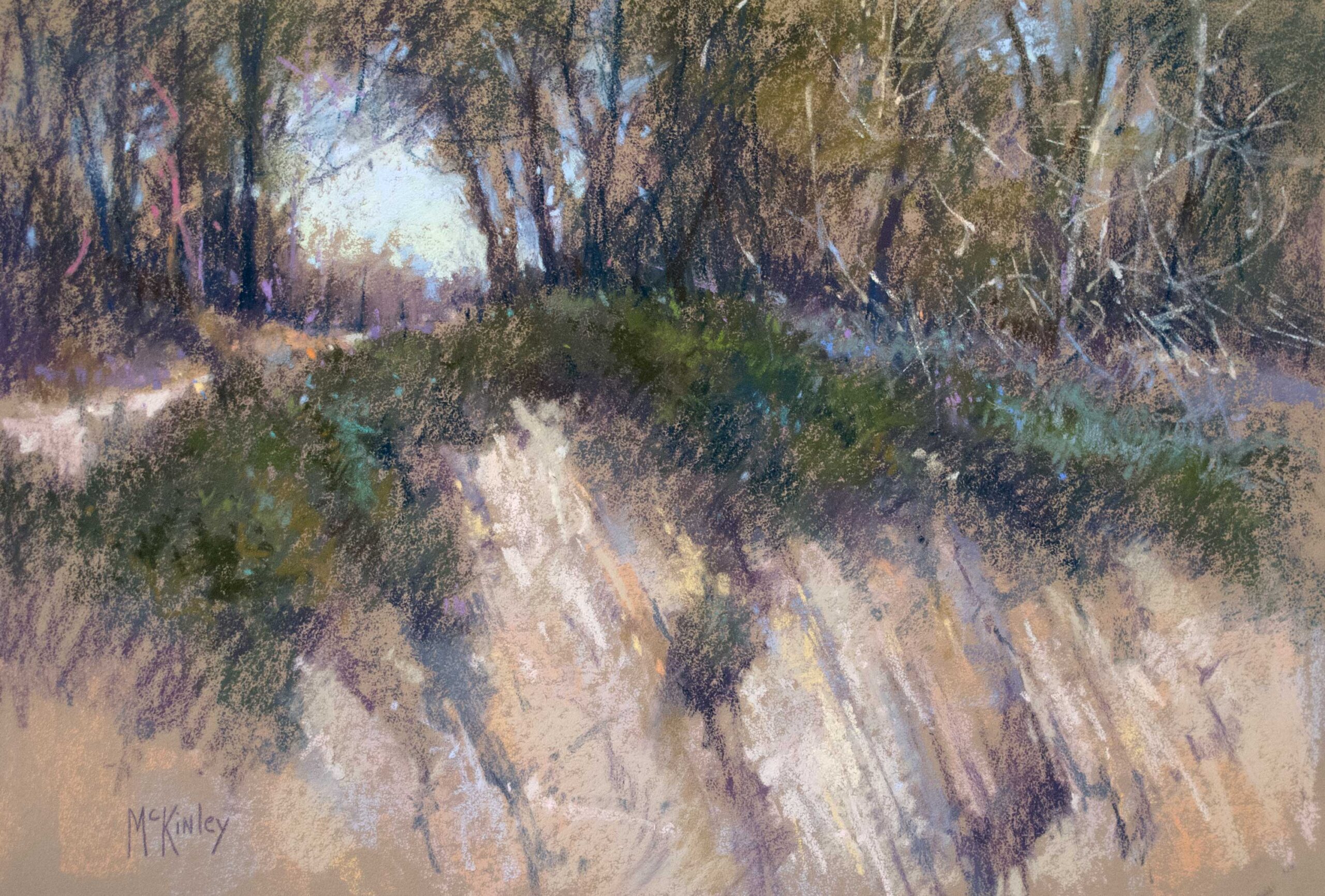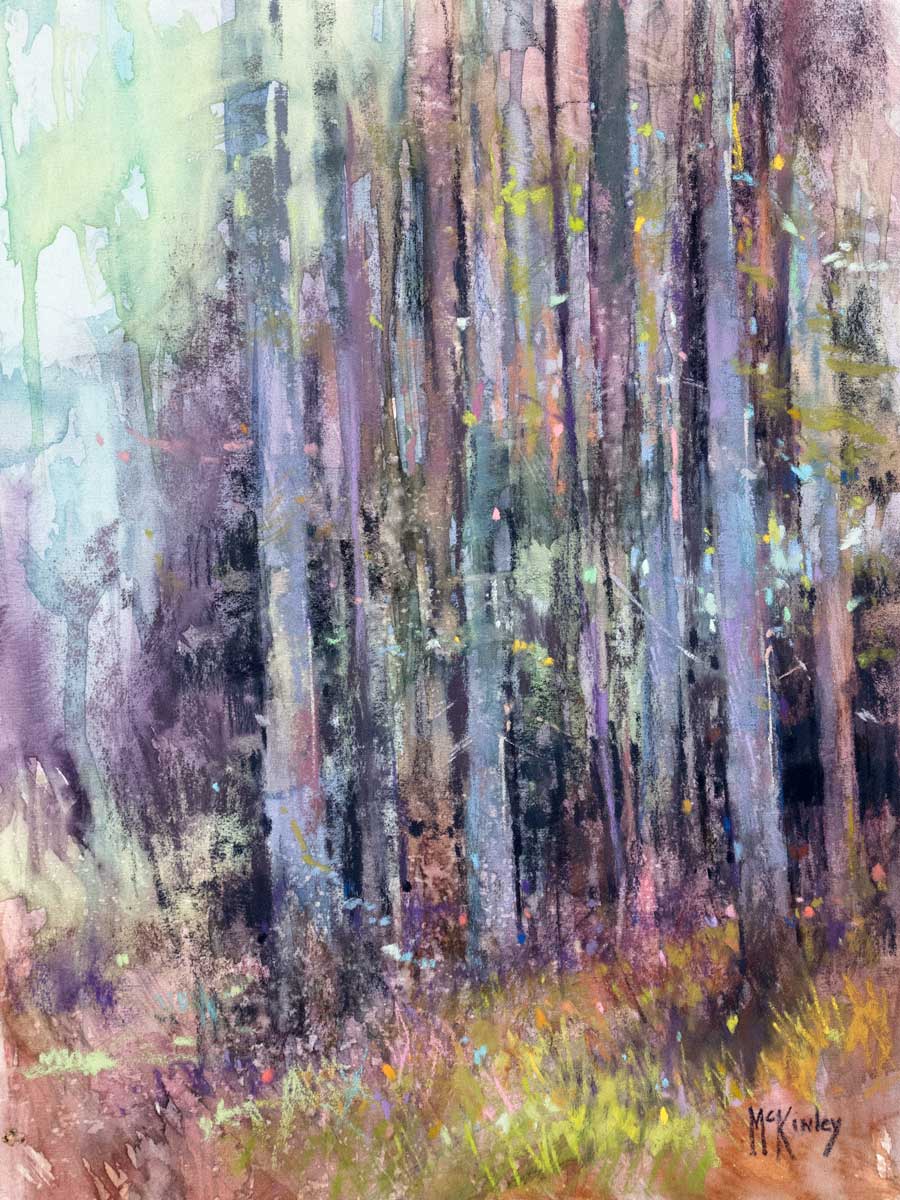Click here to see this email on the web
|
 |
Tuesday, May 9th, 2023
|
|
Making a Personal Creative Statement
|
By Richard McKinley
|
Share this article:    
|
 |
Richard McKinley squints as he makes final adjustments to Pacific Sentinels with a pastel pencil.
|
“Once we’ve mastered the ability to make a tree look like a tree and a rock look like a rock, the real work begins.”
Early in our plein air landscape painting adventures, we focus on honing the technical skills required to make a scene look like it does. If someone recognizes that it is a Lombardy poplar tree we are painting, we are thrilled. Once we’ve mastered the ability to make a tree look like a tree and a rock look like a rock, however, the real work begins. While technical aptitude is rewarding, there is something more waiting – an ability to express a personal vision rooted in how we feel about what we see.
For the majority of my artistic journey, I have focused on the beauty in the mundane, and the sublime found in places that most people wouldn’t give a second glance. Simple groupings of trees have become one of those themes. What is wonderful about commonplace scenes is that they can be found anywhere. Trees, rocks, and fields are abundant and often as close as our backyard. Manipulating textural rhythm, color nuances, and value dynamics becomes the artist’s prerogative.
|
 |
Richard McKinley, “Cliffs of Golita,” 2014, pastel, 12 x 18 in., Private collection, Plein air
|
License to Edit
Orchestrating the visual elements of design is rooted in giving oneself permission to be theatrical. You must pull from a scene the inspiration necessary for motivation, but retain the license to alter, exaggerate, and manipulate whatever may need to be done to communicate your artistic intent. I employ a simple adage associated with representational painting: shape is the identifying component, value (light and dark) gives depth and form, and color is emotion. A simple silhouette, lacking value and color, is recognizable. When value is added, it becomes sculptural. Add color and a specific time of day, and mood can be felt.
|
— advertisement —
|
 |
The techniques we utilize as painters are diverse. Mediums, and their applications, each have a personality. How do we know if one is a good fit until we experience it? Giving oneself permission to taste from the banquet of creative possibilities is important. For myself, I have found that the immediacy afforded by pastel is perfect for working en plein air. Having a full spectrum of color, value range of those colors, and neutrals (grayer versions of those colors) close at hand allows for an intuitive response to what I perceive on site. The playful nature of a wet underpainting adds the serendipitous
ingredient that I need to not become too predictable when painting. The wet underpainting, while purposeful, has a mind of its own. No two are exactly alike, even if I want them to be, so it becomes a dance of sorts – I in the lead, with my underpainting acting as my partner.
|
 |
Richard McKinley, “Tennessee Trees,” 2015, pastel over watercolor, 12 x 9 in., private collection, plein air
|
|
|
|
Depending upon the surface I’ve selected, I can use a variety of mixed-media underpainting applications when painting in pastel. For working on location, I have found watercolor to be especially useful for this purpose. Unlike some solvents, water is readily available, making travel much easier. Plus, watercolor dries quickly, and a bold, wet wash of color, allowed to drip, splash, and run down the surface, creates an atmospheric, dreamlike setup for the ensuing application of pastel. I try to build just enough reality on top of
the underpainting to allow the viewer to understand the scene without losing the added dimension of the dreamy undertone.
I’m not making a watercolor painting; I’m simply using watercolor as a playful setup. For that reason, I’m not precious about the underpainting. If it doesn’t turn out, or provide something I can work with, I can easily correct it with the addition of pastel. What do I have to lose? Nothing! Painting is not a destination; it is a journey. Giving ourselves permission to enjoy the adventures along the way is the reason we should look forward to painting every day.
|
Spend 3 Days Learning From 30 Of The World’s Best Pastel Artists & You’ll Improve Faster and Better Than You Would By Attending Any Art School In America! Learn more at PastelLive.com.
|
— advertisement —
|
 |
A Royal Plein Air Moment
|
 |
Images from @@petethestreet1
|
The Coronation of Charles III and Camilla drew quite the crowd, including plein air painter Peter Brown ("Pete the Street"), who captured the atmosphere on canvas. Check out his video clips from the day on his Instagram page, @petethestreet1
|
— advertisement —
|
 |
— advertisement —
|
 |
|
|
|
|
|
Plein Air Today is committed to protecting and respecting your privacy. We do not rent or share your email address. By submitting your email address, you consent to Streamline Publishing delivering regular email issues and advertisements. To end your Plein Air Today e-mail subscription and associated external offers, unsubscribe here. To learn more about Streamline Publishing events, products, and offerings visit StreamlinePublishing.com
Copyright 2023 Streamline Publishing, Inc. All rights reserved.
PleinAir Today® is a registered trademark of Streamline Publishing, Inc. |
|
|
|
|